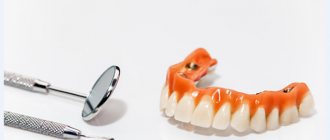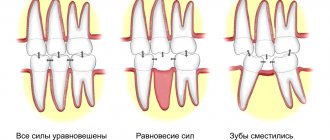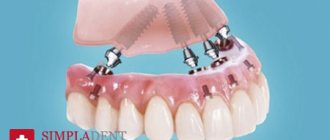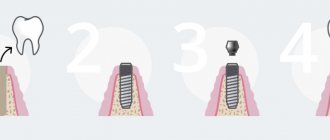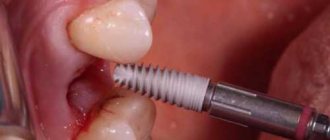What is autologous dental transplantation?
This is a unique surgical operation performed by doctors at our clinic.
Autotransplantation is a procedure in which a healthy tooth is taken from a patient from an area where it is less functional (wisdom tooth, supernumerary tooth). This tooth becomes a donor. It is transplanted to a place where there is a great need for it - if tooth extraction is required (severely damaged tooth, root crack, etc.). That is, autotransplantation is an alternative to traditional implantation. Instead of implanting an implant, your own natural tooth is implanted.
Attention: such a transplant is not possible in all cases; the indications will be determined at a personal appointment and after diagnosis.
Direction: Surgery and implantation
0/0
Autotransplantation is the transplantation of your own tooth. Photo before deletion
After treatment. We implanted a wisdom tooth in place of the extracted tooth.
Doctor: Shirnaliev Ulvi
Details
Direction: Surgery and implantation
0/0
Autotransplantation is the transplantation of your own tooth. Photo before treatment.
A root crack was diagnosed and the tooth was removed.
We implanted a wisdom tooth in place of the extracted tooth.
Doctors: Unzhakova Yulia Kobozev Mikhail
Details
Direction: Surgery and implantation
0/0
Autotransplantation is the transplantation of your own tooth. Before treatment (cracked root of the sixth tooth).
Tooth removed, fitting of wisdom tooth template.
We implanted a figure eight in place of the extracted tooth.
New tooth - after endodontics.
Doctors: Unzhakova Yulia Kobozev Mikhail
Details
What are the alternatives?
The most inexpensive way to replace a missing tooth is to install a removable butterfly denture. But it is quite noticeable from the outside, does not restore chewing function well and does not hold securely, so it should only be considered as a temporary solution to the problem.
Another common method is a bridge, which before the advent of implants was the most popular way to replace a lost tooth. The design consists of connected crowns - the outer ones rest on living teeth, and the central one fits tightly to the gum and closes the void. But to install this prosthesis, you will have to sacrifice two healthy adjacent teeth by grinding them down. And bone atrophy progresses under the prosthesis.
The most optimal alternative is dental implantation. This is the restoration of the crown of a tooth on an implant, which is fixedly installed inside the jawbone, exactly where the root of the living tooth was. However, this treatment will take longer compared to autotransplantation, especially if bone needs to be built up first.
1 Tsukiboshi M, Yamauchi N, Tsukiboshi Y. Long-term outcomes of autotransplantation of teeth: A case series. Dental Traumatology, 2019
How does the autotransplantation process work?
- In order for the transplant to be successful, you need to make sure that the donor tooth is the right size for the socket of the tooth that needs to be removed. The doctor evaluates the shape and size of the donor tooth on a CT image.
- We scan the tooth and print a three-dimensional model of the tooth on a 3D printer. It is made of special plastic.
- The doctor tries on the future donor tooth (this happens even before extraction).
- Next, the dental surgeon atraumatically removes the decayed tooth. Places a 3D model of the future donor tooth into the socket and carries out the final fitting.
- The doctor then very carefully removes the donor tooth and moves it into the socket of the newly removed tooth. Places stitches and strengthens with a splint. The surgical part is completed. Next - inspections.
- You have had a tooth transplant. What is important to know? Recommendations from our doctors!
Cost of implant installation
Egor
I’m writing, maybe the information will be useful to someone. My teeth fell out early and I didn’t want to walk with a denture. But I always thought that I couldn’t afford the cost of implanting ALL teeth. I was smart enough to go to a consultation, and there they explained to me, a complete idiot, that if all my teeth are missing, then I don’t need to get 32 implants. Enough 4 at the top and 4 at the bottom. And prostheses are firmly attached to them. It is much cheaper and quite adequate in cost. This design for one jaw can be ordered from 120 thousand.
Alina
My employee installed an implant in a “budget” clinic for 25 thousand, when I was puzzled by finding a good deal, I found it for 18. They did everything perfectly, the service not only pleased, but really delighted. Once again I was convinced that everyone’s budget is different!
PROMOTION
Osstem dental implantation turnkey
18,000 rub.
Natural rejection of the implant by the body
The reasons for the natural failure of an artificial implant to survive may be:
- allergy to the material from which the implant is made;
- in case of weakened immunity;
- chronic diseases of the body, especially in the acute stage;
- bone injury in the area where the artificial implant is inserted;
- incorrect selection of an implant when the anatomical features of the jaw structure, soft tissues and other factors were not taken into account.
The so-called reimplantitis leads to destructuring of soft tissues and destruction of the patient’s bone. It manifests itself as follows:
- severe bleeding;
- swelling;
- implant mobility;
- detachment of gum tissue by more than a millimeter;
- the formation of purulent fistulous tracts in the cheek, in the lower part of the jaw;
- facial asymmetry;
- abrasion of the hard jaw bone;
- elevated body temperature.
It is important! If you consult a doctor in time, reimplantitis can be treated in a timely manner with powerful prevention, and surgery to remove the implant does not need to be performed. If the condition is advanced, in this case an operation to remove the implant is prescribed, and errors are corrected.
Dental transplantation: pros and cons
Although, at first glance, this technique has many advantages, there is no consensus on this issue in dentistry. The advantages of transplantation include the return of normal chewing of food, prevention of the development of bite defects, and restoration of the beauty of the smile. The key point is that these operations can be performed on children and adolescents who are contraindicated for implantation.
However, there are a number of features pointed out by doctors who are not entirely positive about this technique:
- there is a risk of tooth rejection - this happens in 5-20% of cases;
- in some patients, the roots of transplanted teeth resolve within 2-3 years;
- if the roots of the transplanted teeth fuse with the jaw directly, and not through the periodontal ligament, they will begin to deteriorate quite quickly;
- since wisdom teeth have a very branched root system, additional traumatic manipulations are required to engraft them in place of chewing teeth;
- the need for orthodontic correction.
It is worth noting that the success of engraftment is influenced by the patient’s age and the type of transplant - the follicle engrafts more successfully than an already formed tooth. However, transplants are successful in 80-95% of cases.
Characteristic signs of dental implant rejection
- Aching, cutting, throbbing pain in the area of implantation;
- Swelling of the gum tissue;
- Bleeding gums in the root/implant area;
- Swelling can gradually move to the lips, cheeks, pain can radiate to the neck and even the back of the head;
- Headache;
- Inability to chew food normally;
- Unpleasant odor coming from the mouth;
- Temperature increase;
- General weakness.
If these signs of non-engraftment appear in the first 7–10 days after installation, this is a physiological norm. If they persist, the pain increases, the condition worsens, this is an alarm signal - you need to urgently contact a specialist and take radical action.
Indications and contraindications
Implantation of natural teeth is indicated in the absence of any tooth - in the smile area or in the chewing region. The purpose of such an operation is to restore the full functioning of the dental system, which is very important for children and adolescents.
But this technique also has contraindications:
- lack of sufficient space for transplantation between adjacent teeth;
- autoimmune diseases, disorders of the endocrine, cardiovascular, and nervous systems;
- local inflammation or infection;
- impaired bone tissue restoration;
- insufficient oral hygiene.
Also important is the patient’s psychological readiness to follow all the doctor’s instructions and the ability to undergo such an operation, since it is performed in childhood and adolescence.
Doctor errors leading to dental implant removal
The most common mistakes that lead to implant removal are:
- insufficient diagnosis of the patient’s oral cavity condition, against the background of which the dentist did not identify and eliminate deviations before root implantation;
- lack of bone augmentation or sinus lift of insufficient bone tissue;
- insufficient calculations when choosing the size of the implant;
- an error in the operation, resulting in an infection in the open wound. There may also be poor quality treatment of the instrument with antiseptic solutions;
- the implant is not sufficiently integrated into the bone, and an abutment and crown have already been “placed” on it;
- implantation of an incorrect implant that could not withstand the load, or it was incorrectly distributed to the root;
- use of an implant of dubious quality;
- error in the treatment of pathologies of teeth and gum tissue;
- When the specialist performed the procedure, inaccuracies were made when attaching the implant root rod.
How to minimize the risks of implant rejection
In order not to lose the installed implant, it is important to follow the following recommendations:
- Do not touch the wound with your hands or other objects. In the first few days after implantation, you don’t even have to brush your teeth in close proximity to the implant, so as not to damage the wound in the gum and provoke rejection.
- A day or two after root implantation, you need to visit a doctor’s office for monitoring and possible recommendations for the speedy restoration and preservation of the implant.
- Stop smoking and drinking alcohol for 10 days after implantation to allow the gums to heal and not cause rejection.
- Do not eat hot or very cold foods or solid foods.
- Minimize physical activity for a while: hard work, sports.
- Do not load the implant under any circumstances - take restricted food and liquid for the first few days.
- For a short period of time, protect yourself from visiting the pool, sauna, bathhouse.
- Follow all doctor's instructions; to relieve swelling of the gums, you can apply a cold compress to your cheek.
- Do not forget about preventive cleaning of teeth, gums, and tongue from plaque. It should be done at least twice a year in the dentist's office and will minimize the risk of rejection.
Expert summary: not a single patient is immune from rejection and further removal of the implant. But following the doctor’s recommendations, taking care of your health, being careful with cigarettes, alcohol and physical activity. loads will help preserve the implant, the installation of which costs a lot of money, effort and time.
What determines the service life of a dental implant?
The service life of the implant assumes the warranty specified by the manufacturer on the packaging. Companies that produce premium dental structures, for example, Nobel Biocare, Astra Tech, XIVE Friadent, Straumann, give them a lifetime guarantee . They will not have to be changed unless unforeseen circumstances arise.
Other companies set a period of 20-25 years . After this time, the worn-out implant, if defective, must be removed. Although, with proper care, even such options last longer than the manufacturer indicated.
The service life of titanium roots is affected by:
- qualified work of an implantologist;
- professionalism of the orthopedist in the manufacture of the prosthesis;
- high quality construction;
- proper oral hygiene;
- absence of serious diseases.
The presence of these conditions favors the long-term operation of installed dental systems.
When can an implant be placed after tooth extraction?
The introduction of a titanium root into the jaw bone is carried out according to a one-stage or delayed protocol.
- A one-stage protocol involves implanting an artificial root immediately after removal into the remaining socket or adjacent tissue. When restoring molars, the patient will have to wait for the artificial root to fully engraft. When reconstructing the anterior region, immediate loading with a temporary prosthesis removed from the bite is allowed.
- The delayed protocol involves waiting for complete restoration of bone and soft tissues, followed by installation of an implant. Reconstructive measures begin 2-5 months after resection of the unit. Osseointegration of the titanium root lasts 2-4 months. To form a smooth edge of the mucosa, a gum expander is installed for 2 weeks. That is, implantation can take 4-10 months.
Implementation of a delayed protocol to correct long-standing defects may require prior surgery to restore the volume of the alveolar ridge (osteoplasty).
The duration of treatment is additionally increased by 3-6 months. This is the time required for the implantation of the osteoplastic material.


